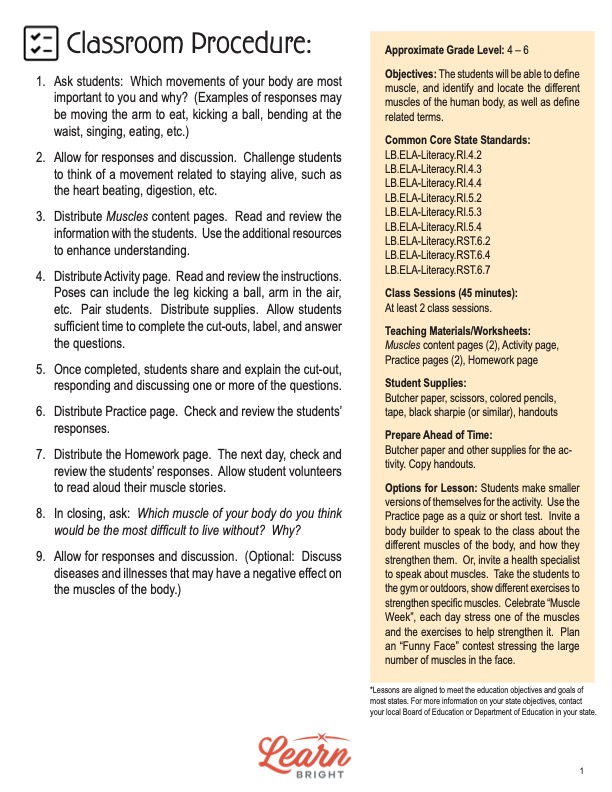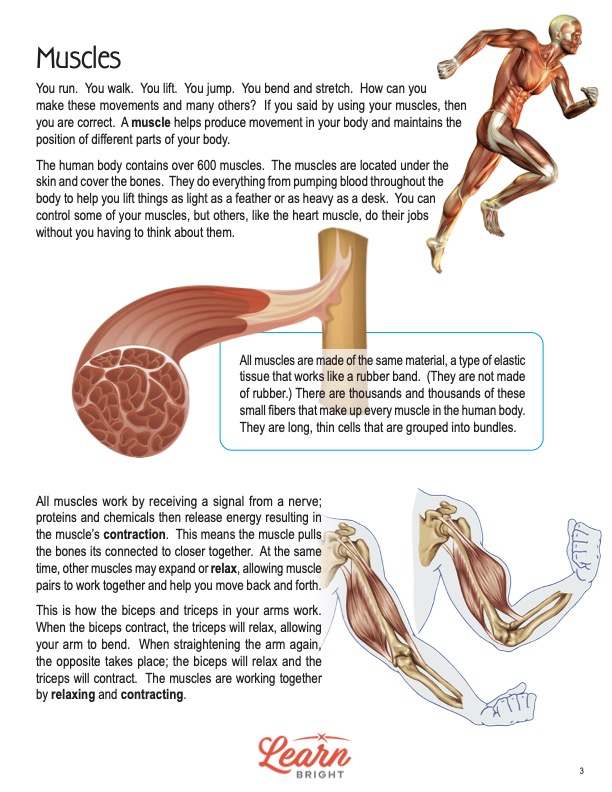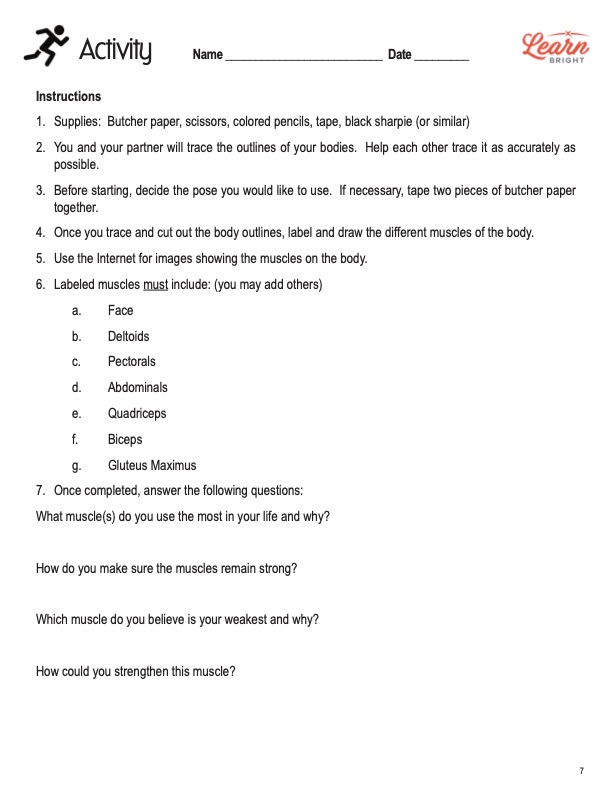Description
What our Muscular System lesson plan includes
Lesson Objectives and Overview: Muscular System explores the most common muscles of the human body. Students will learn to identify and locate these muscles. These include biceps, deltoids, and facial muscles. Students will also learn some terms that relate to this body system. This lesson is for students in 4th grade, 5th grade, and 6th grade.
Classroom Procedure
Every lesson plan provides you with a classroom procedure page that outlines a step-by-step guide to follow. You do not have to follow the guide exactly. The guide helps you organize the lesson and details when to hand out worksheets. It also lists information in the yellow box that you might find useful. You will find the lesson objectives, state standards, and number of class sessions the lesson should take to complete in this area. In addition, it describes the supplies you will need as well as what and how you need to prepare beforehand. For this lesson, the supplies you will need include butcher paper, scissors, colored pencils, tape, and black markers. You are welcome to add to this list if you want to.
Options for Lesson
There are quite a few additional suggestions in the “Options for Lesson” section. One such suggestion is to have students make smaller versions of themselves for the activity. You could use the practice page as a quiz or short test. You could also invite a body builder or health specialist to come speak to the class about different muscles of the body and how to strengthen them. Another option is to take students to the gym or outside and show them different exercises that strengthen certain muscles. You could also plan a “Muscle Week” during which you highlight one of the muscles each day and the exercises that strengthen it. One last option is to plan a “Funny Face” contest that stresses the number of large facial muscles.
Teacher Notes
There is an extra paragraph on the teacher notes page that can provide a little extra information or guidance. It reminds you to emphasize the difference between voluntary and involuntary muscles. It also suggests that you find resources such as videos or interactive games to for students to use. The blank lines provide some space for you to write down any other ideas you have before you give the lesson.
MUSCULAR SYSTEM LESSON PLAN CONTENT PAGES
What Are Muscles?
This lesson contains four content pages. The first page describes what a muscle actually is and how it interacts with the body. Students will learn how running, walking, jumping, and every other movement is possible because of the muscular system. They will learn that muscles produce movement in the body and maintain the position of different body parts. In addition, they will discover that there are over 600 muscles in the human body. Muscles are under the skin and cover bones. They pump blood throughout the body and help the body lift objects. People can control some of their muscles, but not all of them. The heart, for instance, generally does its job without a person thinking about it.
Students will likewise learn that muscles are basically an elastic tissue that work like a rubber band. They will discover how muscles work. First, a muscle receives signals from a nerve and then releases energy through proteins and chemicals. This makes the muscle contract, or pull the bones it connects to closer together. At the same time, other muscles may expand or relax, which allows muscle pairs to work together to help the body move back and forth. The lesson explains that this is what happens with the biceps and triceps in the arms. When biceps contract, triceps will relax, allowing the arm to bend. When straightening the arm again, the opposite occurs — the biceps relax and the triceps contract.
Types of Muscles
During this part of the lesson, students will learn that muscles can be either voluntary or involuntary. Voluntary muscles are those that you can control. Students will learn that they cannot move these muscles unless they cause them to move. Involuntary muscles, on the other hand, are those that move without any cause. The heart is an example of this kind of muscle because it beats regardless of whether someone consciously causes it to do so or not. Students will next learn that there are three main types of muscles in the muscular system: smooth, cardiac, and skeletal.
Smooth: These are involuntary muscles that appear as sheets or layers. The brain sends signals throughout the body to tell the muscle what to do. Examples include the stomach and digestive system, which contract and relax to guide food throughout the body.
Cardiac: This thick muscle makes up the heart and is also known as the myocardium. The muscles of the heart contract to pump blood out and then relax to let blood back in after it circulates through the body. Students will discover that a special group of cells within the heart is the “pacemaker” of the heart because it controls the heart.
Skeletal: These muscles are the voluntary muscles. They cover the bones and provide strength and flexibility to the body. Another name for this group is striated muscles. Tendons hold the muscles together to the bones, acting as connector pieces. The tendons and bones move together as muscles contract. Skeletal muscles come in all shapes and sizes and have different jobs. The most powerful muscles are in the back as they help keep a person upright.
Major Muscles
Students will then learn about some of the major muscles of the body. The face contains many muscles that do not attach directly to a bone. Instead, they attach underneath the skin. An interesting fact students will discover is that it takes 17 muscles to smile but 43 muscles to frown. (This could be a great time to have the “funny face” competition mentioned above.)
Deltoids and pectorals are close together. The deltoids are in the shoulders, and the pectorals are the chest muscle. Students will discover that deltoids are the muscles that contract and relax when they shrug when they don’t know the answer to a question. Many athletes and body builders have large pectoral muscles because they strengthened the upper body over a period of time. Students will also learn about biceps. When they flex their arm, it is most likely the biceps that tense up.
Another major muscle is the gluteus maximus. Students will learn that when they sit down, they sit on their gluteus maximus, or glutes. This is the muscle that is under the skin and fat on the behind. Close by are the quadriceps, or quads. These muscles on the front of the thighs are very important to athletes. Runners, bikers, and other athletes who use their legs in their sport must develop strong quads. By the end, students will discover that the muscles in the muscular system help people exercise, cry, sleep, live, and so much more.
Key Terms
Here is a list of the vocabulary words students will learn in this lesson plan:
- Muscle—a part of the body that helps produce movement and maintain the position of different body parts
- Contract—when a muscle pulls the bones it connects to closer together
- Relax—when a muscle expands after contracting
- Myocardium—a scientific name for the muscles that make up the heart
- Striated muscle—a muscle that covers bones and provides strength and flexibility to the body
- Tendon—a piece of tissue that connects muscles and bones
MUSCULAR SYSTEM LESSON PLAN WORKSHEETS
The Muscular System lesson plan includes three worksheets. Each one tests students’ knowledge or grasp of the concepts they learned about during the lesson. You can refer to the guide on the classroom procedure page to know when to hand out each worksheet.
BODY OUTLINE ACTIVITY WORKSHEET
For the activity, students will work with a partner to outline each other on a large piece of butcher paper. After they finish tracing, they will draw and label the different muscles of the body that they learned about. They can also find images online if they don’t want to draw them. When they finish the outlines, they will answer the four questions at the bottom of the worksheet.
MULTIPLE CHOICE AND MATCH PRACTICE WORKSHEET
There are two sections on the practice worksheet. The first section requires students to answer 15 multiple choice questions. The second section contains two sets of definitions. The first set has a word bank that contains terms from the lesson plan that relate to the muscular system. The second word bank contains seven muscle groups. Students will use each word only once. The lesson plan provides an answer key for this worksheet.
MUSCULAR SYSTEM HOMEWORK ASSIGNMENT
The homework assignment provides students with a diagram of the muscles in the body. Students will use the terms in the word bank to label the muscles in the correct places. Afterward, they will write a short story correctly using a specific list of words. The lesson plan provides an answer key for this worksheet.










